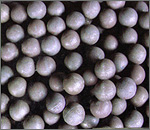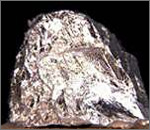Chromium is a chemical element which has the symbol Cr and atomic number 24, first element in Group 6. It is a steely-gray, lustrous, hard metal that takes a high polish and has a h

igh melting point. It is also odourless, tasteless, and malleable. The name of the element is derived from the Greek word "chrōma" (χρωμα), meaning color, because many of its compounds are intensely colored. It was discovered by Louis Nicolas Vauquelin in the mineral crocoite (lead chromate) in 1797. Crocoite was used as a pigment, and after the discovery that the mineral chromite also contains chromium this latter mineral was used to produce pigments as well.
Chromium was regarded with great interest because of its high corrosion resistance and hardness. A major development was the discovery that steel could be made highly resistant to corrosion and discoloration by adding chromium and nickel to form stainless steel. This application, along with chrome plating (electroplating with chromium) are currently the highest-volume uses of the metal. Chromium and ferrochromium are produced from the single commercially viable ore, chromite, by silicothermic or aluminothermic reaction or by roasting and leaching processes. Although trivalent chromium (Cr(III)) is required in trace amounts for sugar and lipid metabolism in humans and its deficiency may cause a disease called chromium deficiency, hexavalent chromium (Cr(VI)) is toxic and carcinogenic, so that abandoned chromium production sites need environmental cleanup.
Weapons found in burial pits dating from the late 3rd century BC Qin Dynasty of the Terracotta Army near Xi'an, China have been analyzed by archaeologists. Although buried more than 2,000 years ago, the ancient bronze tips of crossbow bolts and swords found at the site showed no sign of corrosion, because the bronze was coated with chromium.

Chromium came to the attention of westerners in the 18th century. On 26 July 1761, Johann Gottlob Lehmann found an orange-red mineral in the Beryozovskoye mines in the Ural Mountains which he named Siberian red lead. Though misidentified as a lead compound with selenium and iron components, the mineral was Crocoite (lead chromate) with a formula of PbCrO4.
In 1770, Peter Simon Pallas visited the same site as Lehmann and found a red lead mineral that had useful properties as a pigment in paints. The use of Siberian red lead as a paint pigment developed rapidly. A bright yellow pigment made from crocoite also became fashionable.
In 1797, Louis Nicolas Vauquelin received samples of crocoite ore. He produced chromium oxide (CrO3) by mixing crocoite with hydrochloric acid. In 1798, Vauquelin discovered that he could isolate metallic chromium by heating the oxide in a charcoal oven. He was also able to detect traces of chromium in precious gemstones, such as ruby or emerald.
During the 1800s, chromium was primarily used as a component of paints and in tanning salts. At first, crocoite from Russia was the main source, but in 1827, a larger chromite deposi

t was discovered near Baltimore, United States. This made the United states the largest producer of chromium products till 1848 when large deposits of chromite where found near Bursa, Turkey.
Chromium is also known for its luster when polished. It is used as a protective and decorative coating on car parts, plumbing fixtures, furniture parts and many other items, usually applied by electroplating. Chromium was used for electroplating as early as 1848, but this use only became widespread with the development of an improved process in 1924.
Metal alloys now account for 85% of the use of chromium. The remainder is used in the chemical industry and refractory and foundry industries.


